Related Research Articles
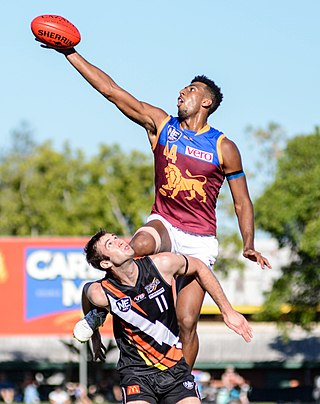
Australian rules football, also called Australian football or Aussie rules, or more simply football or footy, is a contact sport played between two teams of 18 players on an oval field, often a modified cricket ground. Points are scored by kicking the oval ball between the central goal posts, or between a central and outer post.
A drop kick is a type of kick in various codes of football. It involves a player intentionally dropping the ball and then kicking it either 'as it rises from the first bounce' (rugby) or 'as, or immediately after, it touches the ground'.
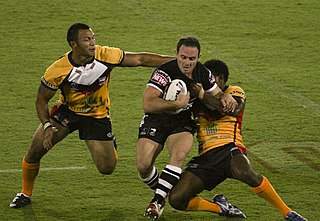
Rugby league football, commonly known as rugby league in English-speaking countries and rugby XIII in non-Anglophone Europe and South America, and referred to colloquially as rugby, football, footy or league in its heartlands, is a full-contact sport played by two teams of thirteen players on a rectangular field measuring 68 m (74 yd) wide and 112–122 m (122–133 yd) long with H-shaped posts at both ends. It is one of the two major codes of rugby football, the other being rugby union. It originated in 1895 in Huddersfield, Yorkshire, England, as the result of a split from the Rugby Football Union (RFU) over the issue of payments to players. The rules of the game governed by the new Northern Rugby Football Union progressively changed from those of the RFU with the specific aim of producing a faster and more entertaining game to appeal to spectators, on whose income the new organisation and its members depended.

Gaelic football, commonly known as simply Gaelic, GAA or Football is an Irish team sport. A form of football, it is played between two teams of 15 players on a rectangular grass pitch. The objective of the sport is to score by kicking or punching the ball into the other team's goal or between two upright posts above the goal and over a crossbar 2.5 metres above the ground.

International rules football is a team sport consisting of a hybrid of football codes, which was developed to facilitate international representative matches between Australian rules football players and Gaelic football players.

Touch rugby refers to games derived from rugby football in which players do not tackle each other but instead touch their opponents using their hands on any part of the body, clothing, or the ball.

Recreational Football was a non-contact version of the Australian rules football game first played in 2003 and later sanctioned by the Australian Football League's game development arm, it was inspired heavily by the growing popularity of tag rugby. It was a more accessible version of Australian rules football that people could pick up and play. It was a mixed competition, with eight players on each team, accessible to players of both sexes, all shapes and sizes and requires minimal equipment to play. Rec Footy was criticised mainly by Australian rules players for appearing similar to netball and being too restrictive, lacking of ability for skilled footballers to run kick and play naturally whilst also penalising newer unskilled players with frequent turnovers.

The laws of Australian rules football were first defined by the Melbourne Football Club in 1859 and have been amended over the years as Australian rules football evolved into its modern form. The Australian Football Council (AFC), was formed in 1905 and became responsible for the laws, although individual leagues retained a wide discretion to vary them. Following the restructure of the Victorian Football League's competition as a national competition and the League's renaming to be the Australian Football League (AFL), since 1994, the rules for the game have been maintained by the AFL through its Commission and its Competition Committee.
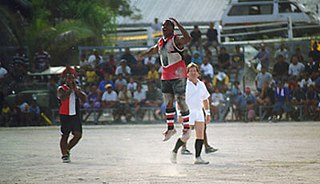
The Geography of Australian rules football describes the sport of Australian rules football played in more than 60 countries around the world. By 2017 more than 26 nations had contested the Australian Football International Cup, the highest level of worldwide competition.

In Australian rules football, a ruck, or ruckman/ruckwoman, is typically a tall and athletic player who contests at centre bounces and stoppages. The ruck is one of the most important players on the field. They are often key to coaching strategy and winning centre clearances which result in the most goal kicking opportunities.
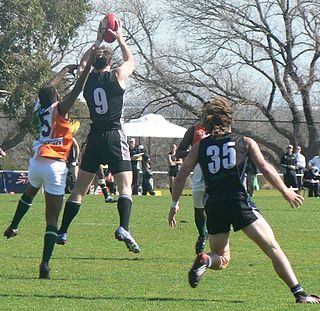
Australian rules football in New Zealand is notable as the first colony outside of Australia to take up the sport as early as the 1860s and was home to the first club formed outside Australia in 1876. The sport's official name was changed in 1890 to Australasian Football acknowledge New Zealand's participation and remained for some time even after the country was expelled from the Australasian Football Council. After a half century hiatus of organised competition, it has grown rapidly as an amateur sport. Today five of New Zealand's sixteen regions have organised competitions: Auckland ; Canterbury ; Wellington ; Waikato and Otago. A four-team national competition with a national draft has been contested at the North Harbour Stadium in Auckland since 2016 for men and 2019 for women. The national team were crowned International champions at the 2005 Australian Football International Cup and competed annually against the AFL Academy between 2012 and 2019. Since the 2010s the game has also grown at junior level among New Zealand schools as the "Hawks Cup".
Universal football was the name given to a proposed hybrid sport of Australian rules football and rugby league, proposed at different times between 1908 and 1933 as a potential national football code to be played throughout Australia and New Zealand. The game was trialled, but it was never otherwise played in any regular competition.
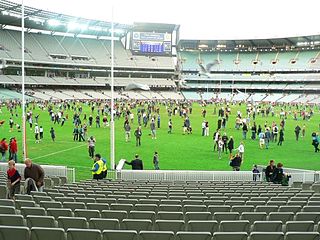
Kick-to-kick is a pastime and well-known tradition of Australian rules football fans, and a recognised Australian term for kick and catch type games. It is a casual version of Australian rules.
Australian rules football in Samoa has been played since 1997.
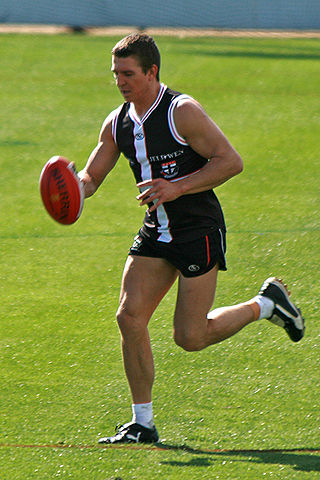
A running bounce, or simply bounce, is a skill in the sport of Australian rules football and some variants where a player bounces the ball on the ground in order to run more than the maximum distance with the ball.

Australian rules football and Gaelic football are codes of football, from Australia and Ireland respectively, which have similar styles and features of play. Notably both are dominated by kicking from the hand and hand passing as well as rules requiring the ball is bounced by a player running in possession, both have a differentiated scoring system, with higher and lower points values for different scoring shots, both have no offside rule, and both allow more physical contact and players on the field than other football codes - 15 in gaelic football, 18 in Australian Rules.
Variations of Australian rules football are games or activities based on or similar to the game of Australian rules football, in which the player uses common Australian rules football skills. They range in player numbers from 2 up to the minimum 38 required for a full Australian rules football.

This list is an alphabetical glossary of Australian rules football terms, jargon and slang. While some of these entries are shared with other sports, Australian rules football has developed a unique and rich terminology.

Football is a family of team sports that involve, to varying degrees, kicking a ball to score a goal. Unqualified, the word football normally means the form of football that is the most popular where the word is used. Sports commonly called football include association football ; Australian rules football; Gaelic football; gridiron football ; International rules football; rugby league football; and rugby union football. These various forms of football share, to varying degrees, common origins and are known as "football codes".
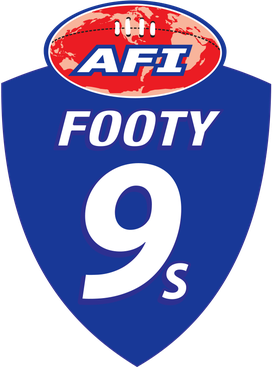
Footy 9s is a version of Australian rules football created by Australian Football International.